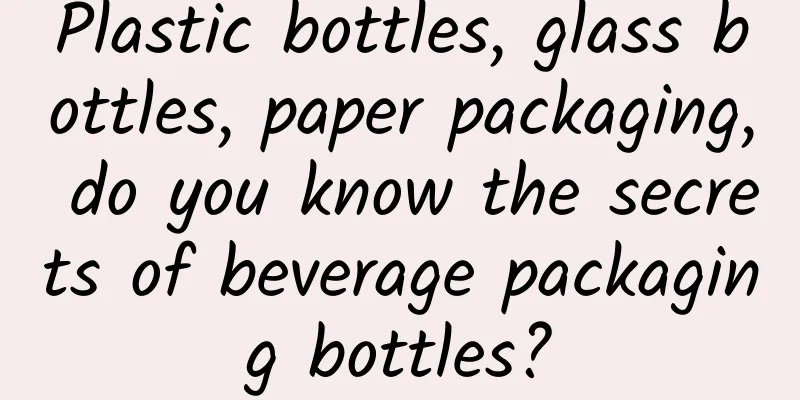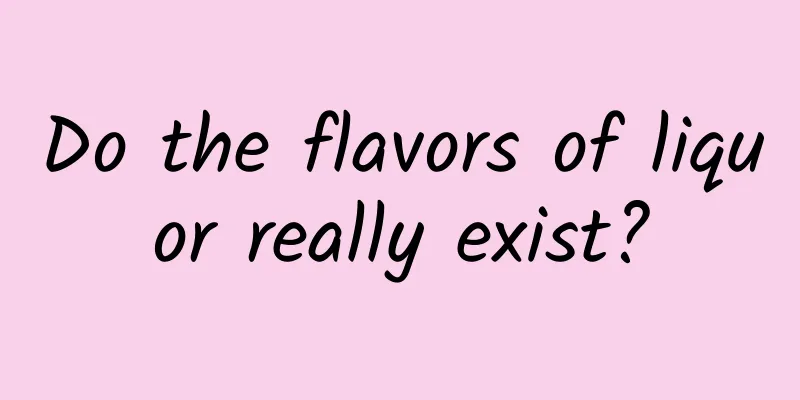Plastic bottles, glass bottles, paper packaging, do you know the secrets of beverage packaging bottles?

|
When the weather gets hot, the first thing people think of is to buy various beverages to cool down. However, if you pay close attention, you will find that the beverage packaging on the market is quite different. Is there any secret in choosing beverage packaging materials? Various packaging is dazzling丨TuChong Creative In fact, according to the different materials used, the beverage packaging on the market mainly includes four types: polyester bottles (PET), metal, paper packaging and glass bottles, which have become the "four major families" in the beverage packaging market. In terms of market share, glass bottles account for about 30%, PET accounts for 30%, metal accounts for nearly 30%, and paper packaging accounts for about 10%. 01 Ancient packaging materials / Glass/ Glass is the oldest of the four major families and is also the packaging material with the longest history of use. Everyone should have the impression that in the 1980s and 1990s, the soda, beer, and champagne we drank were all packaged in glass bottles. Even now, glass still plays an important role in the packaging industry. Glass bottle packaging | Tuchong Creative Glass containers are non-toxic and tasteless, and they look transparent, so people can see the contents clearly at a glance, giving people a sense of beauty. Moreover, they have good barrier properties and are airtight, so there is no need to worry about spilling or insects getting in after being left for a long time. In addition, they are inexpensive, can be cleaned and disinfected many times, and are not afraid of heat or high pressure. They simply have a myriad of advantages in one, so they are used by many food companies to hold beverages. They are especially not afraid of high pressure, and are very suitable for carbonated beverages, such as beer, soda, and juice. However, glass packaging containers also have some disadvantages. The main problem is that they are heavy, brittle and easy to break. In addition, it is not convenient to print new patterns, icons and other secondary processing, so the current usage is getting less and less. Nowadays, beverages made of glass containers are basically not seen on the shelves of large supermarkets. Only in schools, small shops, canteens, small restaurants and other places with low consumption power can you see carbonated drinks, beer, soy milk, etc. in glass bottles. 02 Cans / Metal/ In the 1980s, metal packaging began to appear on the stage. The emergence of metal canned beverages has improved people's living standards. At present, metal cans are divided into two-piece cans and three-piece cans. The material used for three-piece cans is mostly tin-plated thin steel plates (tinplate), and the material for two-piece cans is mostly aluminum alloy plates. Because aluminum cans have better sealing and ductility, and are also suitable for low-temperature filling, they are more suitable for beverages that produce gas, such as carbonated beverages, beer, etc. At present, aluminum cans are more widely used than iron cans in the market. Almost all canned beverages you can see are packaged in aluminum cans. The first aluminum can that came into people's sight in the Chinese market was the packaging of "Jianlibao", which I think many people should still remember. Jianlibao in old packaging丨TuChong Creative However, the most representative herbal tea beverages in the Guangdong market in my country, such as Wanglaoji, Chunhetang, and Denglao Herbal Tea, are packaged in tinplate cans, which give them a thicker feel. The one on the left is a two-piece can (aluminum can), and the one on the right is a three-piece can (tinplate can). You can distinguish them by looking at whether the bottom of the bottle is one piece, or by the hardness. There are many advantages of metal cans. They are not easy to break, easy to carry, not afraid of high temperature and pressure, changes in air humidity, and not afraid of erosion by harmful substances. They have excellent barrier properties, are light-proof and gas-proof, can prevent air from entering and causing oxidation reactions, and keep beverages for a longer time. Moreover, the surface of metal cans is decorative and easy to draw various patterns and colors. Therefore, most beverages in metal cans are colorful and the patterns are also very rich. Finally, metal cans are easy to recycle and reuse, which is more environmentally friendly. However, metal packaging containers also have their disadvantages. On the one hand, they have poor chemical stability and are afraid of both acid and alkali. Too high acidity or too strong alkalinity will slowly corrode the metal. On the other hand, if the inner coating of the metal packaging is of poor quality or the process is not up to standard, the beverage will change its taste. 03 Dairy Favorites / Paper packaging/ In the early days, paper packaging generally used high-strength original paperboard. However, pure paper packaging materials are difficult to use in beverages. Now, paper packaging is almost all paper composite materials, such as Tetra Pak, Combibloc and other paper-plastic composite packaging containers. Various Tetra Pak packaging | Flickr / Tetra Pak The PE film or aluminum foil inside the composite paper material can avoid light and air, and will not affect the taste, so it is more suitable for short-term fresh milk, yogurt and long-term fresh dairy drinks, tea drinks and juices. The shapes include Tetra Pak pillows, sterile square bricks, etc. However, the pressure resistance and sealing barrier of paper-plastic composite containers are not as good as glass bottles, metal cans and plastic containers, and they cannot be heated and sterilized. Therefore, during the storage process, the heat sealing performance of preformed paper boxes will be reduced due to oxidation of the PE film, or they will become uneven due to creases, etc., causing difficulties in feeding the filling and molding machine. 04 Everywhere / Plastic packaging/ Plastic packaging is very common in the beverage industry. Soda, fruit juice, vegetable juice, herbal tea and other beverages all have plastic packaging products. Many fruit juice drinks are in plastic bottles丨TuChong Creative If you usually look at the bottom of plastic bottles, you will find that most of them have the following icons on the bottom or the side near the bottom. This is a universal plastic classification in the world. Different numbers represent plastics of different materials. At present, there are several types of plastic bottles that are most commonly used in the beverage industry. Plastic classification icons丨Photographed by 呲呲 No. 1 Plastic PET PET stands for polyethylene terephthalate, a very commonly used resin material that belongs to Class 1 in the plastic classification mark. The plastic bottles of mineral water, juice, and carbonated drinks that we usually drink are made of it. The proportion of PET bottles used in domestic carbonated beverage packaging is close to 60%. No. 2 HDPE, No. 4 LDPE Both of these are polymers made by polymerizing ethylene as a monomer. Polyethylene (PE) is the largest variety of general synthetic resins. According to different forms of polymerization, it mainly includes low-density polyethylene (LDPE) and high-density polyethylene (HDPE). Both of these materials have poor heat resistance and are easy to melt and deform when heated. Therefore, try not to use them at high temperatures. Plastic classification on a plastic can | Wikipedia No. 5 Polypropylene (PP) Food-grade PP has good heat resistance, so lunch boxes that can be heated in the microwave are made of PP. Now many take-out milk tea and coffee cup lids also use it. The coffee lid is made of PP丨Photographed Other models No. 3 PVC (polyvinyl chloride) is a polymer material made by polymerizing vinyl chloride monomers. The most common PVC products in daily life are plastic pipes; No. 6 is polystyrene (PS); and the bottled water used in water dispensers is made of No. 7 polycarbonate (PC), but the No. 7 mark also refers to several other types of plastics. References: [1] He Yang, Liu Xiaoze, Shang Shibo, et al. Current status of research on safety of beverage alcohol packaging materials[J]. Journal of Food Safety and Quality, 2018, 9(20): 5482-5486. DOI: 10.3969/j.issn.2095-0381.2018.20.036. [2] Zhu Danqian, Weng Feifei. Overview of Carbonated Beverage Packaging Materials[J]. Modern Food, 2016(10):56-57. DOI:10.16736/j.cnki.cn41-1434/ts.2016.10.020. [3] Li Yanli. Research on the influence of lipid oxidation on soft packaging of milk beverages and material selection[D]. Jiangsu: Jiangnan University, 2009. DOI:10.7666/d.y1583677. [4] Liao Liang. Analysis of tea beverage packaging materials[J]. Food and Drug A, 2005, 7(6): 43-44. DOI: 10.3969/j.issn.1672-979X.2005.06.017. [5] Hu Shaofang. Beverage packaging materials and their new development trends [J]. China Food Industry, 2005(5):32-33. DOI:10.3969/j.issn.1006-6195.2005.05.011. [6]Xu Xinxin. Various materials for beverage packaging show their magical power[J]. Chinese and Foreign Food, 2007(5):48-49. [7] Duan Lili, Ju Ronghui, Wang Hui, et al. Investigation on the types of packaging materials and migration of harmful substances in five types of food on the market[J]. Journal of Beijing Agricultural Vocational College, 2018, 32(4): 52-58. DOI:10.3969/j.issn.1671-7252.2018.04.009. [8] Focus on the five elements of beverage packaging[J]. China Packaging, 2020, 40(9):6. Source: Nutritionist Ruan Guangfeng |
<<: How can afforestation change China?
Recommend
Leaked data shows Microsoft's mobile strategy is working
Although the annual Global Developers Conference ...
Marketing campaign analysis in 2022
How is the marketing campaign at the beginning of...
The download cost is 5.6 cents? This is how you should use Tencent’s 10 billion social advertising traffic!
Some time ago, Tencent announced that it would in...
Hupu APP Product Analysis Report
This article conducts product experience and anal...
25 Marketing Operation Experiences That Will Keep Opening Your Mind (Part 2)
There is no standardized perfect solution for mar...
It's not a weird story, this photographer captured the real version of the "aquarium elephant"
The annual Wildlife Photographer of the Year comp...
Practical experience sharing on Xiaohongshu operation and promotion
As of January this year, Xiaohongshu has more tha...
How did Pinduoduo rise? An article explains the underlying logic of its traffic
The three words "Pinduoduo" are synonym...
"Nezha 2" has exceeded 10 billion box office! These three types of people are not recommended to watch the 3D version
Review expert: Peng Guoqiu, deputy chief physicia...
These 10 little things are not selfish even if you do them!
We have been taught since childhood not to be &qu...
Surprisingly, the accuracy of "Dog Doctor" in cancer detection is as high as 97%
The working dogs we hear more about in our lives ...
Zuckerberg pays tribute to WeChat, but can Facebook Pay be as successful as WeChat Pay?
The digital stablecoin Libra has failed, what wil...
Academician Li Deren won the 2023 National Highest Science and Technology Award! He promoted China's surveying, mapping and remote sensing from a big country to a strong country.......
On June 24, 2024, the 2023 National Highest Scien...
Four lessons I learned from paying for knowledge for 5,000 yuan in the past two years
I know so many things, but I still can’t live a g...
PS4 Japanese version of "Dragon Quest Heroes 2": The Famitsu score is 39 points. Is it a PY transaction or a true masterpiece?
Dragon Quest Heroes 2 is a new "Musou" ...









